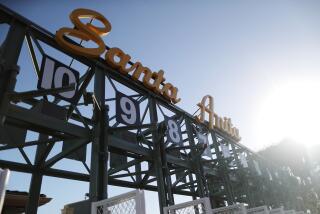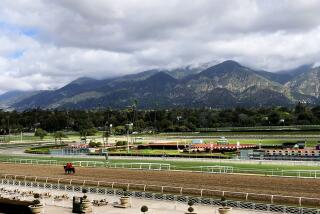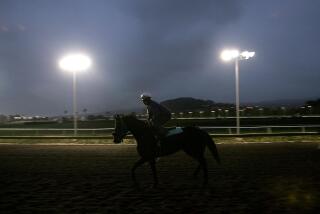After 300 Years, Racing Here Is Still the Sport of Kings
- Share via
LONDON — English race tracks and Scottish golf courses have a lot in common. They all seem to be out in the country and look a little worn, as if they have been around about 200 or 300 years. Some of them have been, of course.
Most of the grass tracks on which the horses race are about as uneven as the fairways at St. Andrews and Carnoustie.
The famous Derby at Epsom, England’s premiere race, is a 1 1/2-mile test run on a course that is decidedly uphill for the first half-mile, level for about two furlongs and then quite sharply downhill round the bend to Tattenham Corner and all the way up the stretch until approaching the final furlong, from where there is a fairly sharp rise. The course for 5-furlong races is straight and sharply downhill.
Newbury has one straightaway course a mile long that is as undulating as a green created by Robert Trent Jones. At many tracks, including Sandown Park, the horses race steadily downhill, level off for a few furlongs and then face a steep climb to the finish.
The English tracks are so different in shape, character and location than their U.S. counterparts, that racing is virtually another sport here. On the other hand, the English give the U.S. tracks an edge in, as one bookmaker put it, “standards of service.”
The racing of horses for sport was started in England by King Charles II, the Merry Monarch, more than 300 years ago at Newmarket, a 2,500-acre heath in East Anglia, 64 miles from London and 13 from Cambridge.
Newmarket, a village with a population of almost 10,000 today, was a popular playground in the early 1600s for King James I, who stabled race horses there.
In 1664, King Charles II started a race called the Town Plate and the tradition of spring and autumn meetings which continues today. King Charles, in fact, rode the winner of the first Town Plate, or so historians have recorded. When King Charles died in 1684, Newmarket was England’s most fashionable sports center.
Today, Newmarket Heath is home of the Jockey Club, the headquarters of English racing, which was established in 1752.
It is also a popular stop on the English racing circuit and one of the few major training centers in the country. It is a right-handed course; that is, the horses race clockwise.
Actually, Newmarket has two courses but one, the July course, is used only in June, July and August.
The other, the Rowley Mile course, has a straight run of 1 miles. Here is how the track has been described: “Races of 1 1/2 miles and upwards start beyond the Devil’s Dyke and bear right-handed into the straight at the 1-mile start. The straight is fairly level until descending into The Dip beside The Bushes 2 1/2 furlongs from home. The final furlong is uphill.”
Devil’s Dyke is a landmark behind which all long races start unseen, it should be said, by anybody in the stands. It is a formidable mound that dominates the heath, running across it for eight miles. In all probability, it is recorded in a history book at the Racing Museum in downtown Newmarket, “the dyke was intended to guard against invasions from the West.”
On important race days, Newmarket attracts crowds of 20,000 to 23,000.
The wind blows often at Newmarket, coming off the North Sea unchecked by any mountain. The heath stretches out on either side of town and its expanse is so unbroken, horses can gallop across the flat for two straight miles. It was once a training ground for battle chariots.
Goodwood, or “Glorious Goodwood,” as it is known here, is unique even in England for its beauty. It is in the countryside south of London only a few miles from the sea. The nearest town is Chichester, but only the steeple of its cathedral is visible from the hill on which sits the elegant little race course.
Actually, Goodwood is a 12,000-acre estate, the historic Sussex seat of the Dukes of Richmond and Gordon. The Goodwood House, a lovely mansion at the entrance of the estate, has been the home of dukes and earls since 1697. The ninth Duke of Richmond lives there today, as does his son, Lord March, 56, who is chairman of the Goodwood Companies and runs the racing. The third Duke of Richmond held the first races at Goodwood in 1801.
The stables behind the parade ring were built in 1757 and can handle about 100 horses. Part of the course is 700 feet above sea level, and from the grandstand on a clear day, spectators can see a long stretch of the Sussex coast and the Isle of Wight in the English Channel. It is a fact, the Goodwood folks say, that if they can see the Isle of Wight, rain at Goodwood is a sure thing.
Goodwood is a right-handed track. The horses start five- and six-furlong races far up a hill to the right of the stands and immediately run downhill before leveling off and heading for the finish. On those shorter races, the horses run a straight course.
The track has a triangular right-hand loop circuit for longer races, which start so far across the countryside, bettors must wait for the track announcer to tell them how their horse is faring. The turns and the pronounced gradients make Goodwood what the English call “a sharp track.”
English tracks do not make as much money as do Santa Anita and Hollywood Park, so to keep Goodwood going Lord March leans on other estate businesses such as farming and forestry.
He also has a 50-room hotel, a golf course, an airfield where flying is taught and an auto race course. It was there, in fact, in 1962, that Stirling Moss, the famous English grand prix driver, had the accident that took him out of racing.
Today at Ascot, racing is held in an attractive setting on land owned by the Crown. Queen Elizabeth is a racing fan and her daughter, Princess Anne, is a competent equestrian and a jockey who sometimes rides in amateur races.
Queen Elizabeth has private quarters at Ascot near the paddock ring, but she uses them only four days a year, at the Royal Ascot meeting in June. Each day at that meeting, Her Majesty is driven over from Windsor Castle and boards a royal coach for a seven-furlong drive down the track to the royal box.
Ascot is a 45-minute train ride from London’s Waterloo Station. At first glance, once you reach Ascot’s main street after a 10-minute walk from the railway station, there doesn’t seem to be a race track where one is supposed to be. Red brick walls and buildings that look as if they belong to an industrial plant are all that are visible from the street.
But hidden behind that brick facade is perhaps England’s most famous race track. It was sung about in “My Fair Lady.”
There is a multi-story grandstand and acres of green lawn and large, lovely old trees. Early arriving spectators sit on benches under the trees reading the Sporting Life and marking their betting sheets.
Others sit in the sun at a champagne and seafood bar, eating poached salmon ($9.50), half a lobster ($11.50) or crab claws or prawns ($7.50). Bottles of champagne cool in silver buckets.
Concrete bleachers encircle the paddock ring, which is as smooth as a golf green. Brick stables are hidden back in the trees.
Gatemen, who are mostly elderly, retired and distinguished looking, direct foot traffic and answer questions at all the enclosures. They all wear dark suits and black bowlers. Jockey Steve Cauthen hurries into the weighing room one-half hour before the first post, looking sharp in a dark suit. Ascot does not attract the jeans-and-boots set.
The racing surface seems to stretch for miles across the heath. The seven-furlong straightaway has as many undulations as a beginner’s ski run. Horses must climb a small hill at the first right-hand turn of longer races.
There are only 13 days of flat racing at Ascot from January to early November, and nine more days of jumping. One-day meetings are held in February and May.
In the members’ enclosure there are 280 private boxes, seating 8 to 12. Each one has its own dining room. Cost: $2,900 to $8,700 for the season.
Otherwise, seating at Ascot is divided, as it is at all tracks, into the members’ enclosure, Tattersalls Ring and the Silver Ring. The Tattersalls Ring ($8) is about like the clubhouse at California tracks. Tickets to the Silver Ring cost about $5. Asked who sits there, one gateman replied, “The roughs.”
Foreigners must apply for tickets to the Royal Enclosure for Royal Ascot week through their ambassadors. Cost for the four days: $75. Daily tickets are $30. You must be properly attired, of course. And only “ladies and gentlemen” need apply.
More to Read
Go beyond the scoreboard
Get the latest on L.A.'s teams in the daily Sports Report newsletter.
You may occasionally receive promotional content from the Los Angeles Times.










